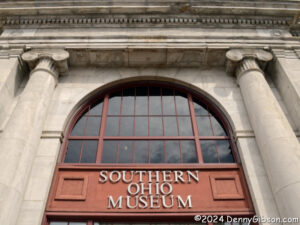 Let’s make it four. With nothing planned for the week following a string of three museum visits, my thoughts naturally turned to extending the streak. Museum visit number one was the result of an online article, number two happened because of a friend’s suggestion, and number three came from a search for “Cincinnati museums”. Thinking to extend the range along with extending the streak, I searched for “southern Ohio museums” and found not only several museums in that area but one with that exact name.
Let’s make it four. With nothing planned for the week following a string of three museum visits, my thoughts naturally turned to extending the streak. Museum visit number one was the result of an online article, number two happened because of a friend’s suggestion, and number three came from a search for “Cincinnati museums”. Thinking to extend the range along with extending the streak, I searched for “southern Ohio museums” and found not only several museums in that area but one with that exact name.
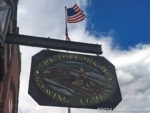
 A sunny day was all it took to get me to head to the Southern Ohio Museum in Portsmouth, Ohio. Without question, my willingness to make the two-hour drive was boosted by the fact that Portsmouth has a mighty fine brewery and an outstanding collection of Robert Dafford murals.
A sunny day was all it took to get me to head to the Southern Ohio Museum in Portsmouth, Ohio. Without question, my willingness to make the two-hour drive was boosted by the fact that Portsmouth has a mighty fine brewery and an outstanding collection of Robert Dafford murals.


 A small group of students were being given a tour of the museum’s lower gallery when I arrived and I briefly tried to eavesdrop on their guide but soon gave that up as a bad idea and headed upstairs. Here the displays are mostly semi-permanent. Many items displayed are from the museum’s permanent collection but may change from time to time. The photos are of works by Ohio artists Gretchen Stevens Cochran, Craig McDaniel, and Clarence Holbrook Carter. Everything in the museum has an Ohio connection of some sort.
A small group of students were being given a tour of the museum’s lower gallery when I arrived and I briefly tried to eavesdrop on their guide but soon gave that up as a bad idea and headed upstairs. Here the displays are mostly semi-permanent. Many items displayed are from the museum’s permanent collection but may change from time to time. The photos are of works by Ohio artists Gretchen Stevens Cochran, Craig McDaniel, and Clarence Holbrook Carter. Everything in the museum has an Ohio connection of some sort.
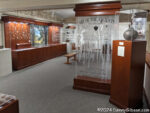
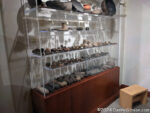
 “Art of the Ancients” is the only truly permanent exhibit in the museum. Thousands of artifacts from the Adena, Hopewell, and other indigenous cultures are displayed here. The museum occupies the former headquarters of the Security Central National Bank of Portsmouth and some of the bank’s coin-related trim can be seen in the third photo. In that same photo, Gretchen Stevens Cochran’s “Bounty or Burden” can be seen in the background.
“Art of the Ancients” is the only truly permanent exhibit in the museum. Thousands of artifacts from the Adena, Hopewell, and other indigenous cultures are displayed here. The museum occupies the former headquarters of the Security Central National Bank of Portsmouth and some of the bank’s coin-related trim can be seen in the third photo. In that same photo, Gretchen Stevens Cochran’s “Bounty or Burden” can be seen in the background.
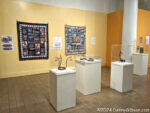 When I returned to the first floor, the students were wrapping up their tour at the far end of the gallery. This space is used for temporary exhibits and is currently occupied by “The Power of the Object“. Maureen Cadogan’s collection of objects from “the journey and experience of African American people” is augmented with several quilts made by neighbor Holly Davis. The exhibit is arranged chronologically with some of the oldest items in the collection being the slave collars in this photo.
When I returned to the first floor, the students were wrapping up their tour at the far end of the gallery. This space is used for temporary exhibits and is currently occupied by “The Power of the Object“. Maureen Cadogan’s collection of objects from “the journey and experience of African American people” is augmented with several quilts made by neighbor Holly Davis. The exhibit is arranged chronologically with some of the oldest items in the collection being the slave collars in this photo.
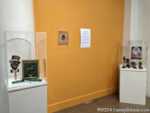
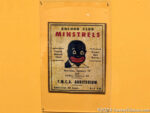 The poster on the wall in the grouping just beyond the collars really drew my interest because of some personal memories. The text beside the poster says “Though Minstrel shows gradually disappeared from professional theaters, its impact and imagery continued… well into the twentieth century.” To that, I can attest. My high school staged minstrel shows as late as 1964 or ’65. I recall two of these shows and a school yearbook indicates these were during my freshman and senior years. There is no information reported about the actual shows. The indications I refer to are individual students listing the shows among their activities. I listed participation during my freshman year only. I recall being in the chorus and a short skit but I’m sure that by the time of that second show, it had become apparent to all that my presence in any vocal group was not helpful. I have found no photos of these shows. The closest is a small picture of a parade presumedly promoting the 1964/5 show. I believe that is me carrying the bass drum.
The poster on the wall in the grouping just beyond the collars really drew my interest because of some personal memories. The text beside the poster says “Though Minstrel shows gradually disappeared from professional theaters, its impact and imagery continued… well into the twentieth century.” To that, I can attest. My high school staged minstrel shows as late as 1964 or ’65. I recall two of these shows and a school yearbook indicates these were during my freshman and senior years. There is no information reported about the actual shows. The indications I refer to are individual students listing the shows among their activities. I listed participation during my freshman year only. I recall being in the chorus and a short skit but I’m sure that by the time of that second show, it had become apparent to all that my presence in any vocal group was not helpful. I have found no photos of these shows. The closest is a small picture of a parade presumedly promoting the 1964/5 show. I believe that is me carrying the bass drum.
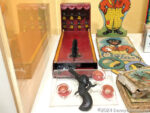
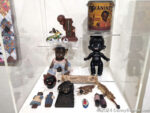
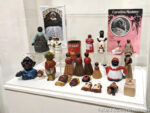 I also have some vague memories of seeing items similar to those in the mammy-themed display in the homes of relatives and friends. I have less vague memories of an alligator pencil holder like this one at my grandparents’ house. I do not have any personal memories of the toys in the third photo but a recent online discussion about a real-life version of the Baby Rack game that a friend encountered while researching amusement parks made this pressed steel version jump out at me. Brinkman Engineering Company is now Brinkman Tool & Die and no longer manufactures toys of any sort.
I also have some vague memories of seeing items similar to those in the mammy-themed display in the homes of relatives and friends. I have less vague memories of an alligator pencil holder like this one at my grandparents’ house. I do not have any personal memories of the toys in the third photo but a recent online discussion about a real-life version of the Baby Rack game that a friend encountered while researching amusement parks made this pressed steel version jump out at me. Brinkman Engineering Company is now Brinkman Tool & Die and no longer manufactures toys of any sort.
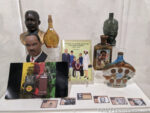
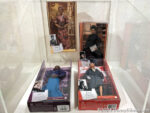 There is indeed power in these objects. They clearly can bring back memories including some that aren’t particularly welcome. It is also pretty obvious that they can make things outside our personal experience more real. Objects near the exhibit’s end provide evidence that as crappy as race relations sometimes seem, they have improved.
There is indeed power in these objects. They clearly can bring back memories including some that aren’t particularly welcome. It is also pretty obvious that they can make things outside our personal experience more real. Objects near the exhibit’s end provide evidence that as crappy as race relations sometimes seem, they have improved.
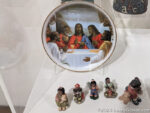 I’m sure I would have enjoyed visiting the Southern Ohio Museum regardless of what was in the temporary gallery but I’m very happy that I learned of the museum before “The Power of the Object” goes away. That will happen in just a few days, on March 27. Other exhibits will follow, of course, and I now have a reason on beyond murals and brews to visit Portsmouth.
I’m sure I would have enjoyed visiting the Southern Ohio Museum regardless of what was in the temporary gallery but I’m very happy that I learned of the museum before “The Power of the Object” goes away. That will happen in just a few days, on March 27. Other exhibits will follow, of course, and I now have a reason on beyond murals and brews to visit Portsmouth.
